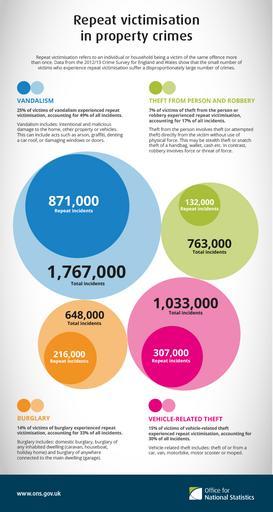MAKE A MEME
View Large Image

| View Original: | Repeat victimisation in property crimes.png (700x1314) | |||
| Download: | Original | Medium | Small | Thumb |
| Courtesy of: | commons.wikimedia.org | More Like This | ||
| Keywords: Repeat victimisation in property crimes.png en The Crime Survey for England and Wales CSEW shows substantial falls in property crime with levels having fallen by half since they peaked in the mid-1990 Ös These falls were driven by large reductions in crimes such as vandalism vehicle-related theft and burglary While these high volume crime types continue to show falls in contrast recent trends show increases in the lower volume personal theft offences such as theft from the person recorded by the police In the 2012/13 CSEW the most commonly stolen item in incidents of theft from the person other theft of personal property other household theft and burglary were purses/wallets Cash/foreign currency was the most commonly stolen item in incidents of robbery Mobile phones were also commonly stolen in incidents of theft from the person and robbery The 2012/13 CSEW shows that levels of repeat victimisation varied by type of property crime offence Vandalism had the highest repeat victimisation rate with 25 of victims of this crime reporting they had suffered vandalism more than once in the previous 12 months Theft from the person and robbery were least likely to have been experienced more than once 7 Changes in levels of repeat victimisation have been important in influencing long-term crime trends Across all types of property crime declines in the number of crimes estimated by the CSEW have been more marked for repeat incidents than for one-off incidents Across all property crime types except theft from the person and robbery the proportion of victims in the 2012/13 CSEW who were victimised more than once has fallen since CSEW crime peaked in 1995 The most common home security devices present in households in England and Wales were window locks and double locks or deadlocks Eighty-eight per cent of households had locks on their windows and 83 had double locks or deadlocks on at least some of their outside doors In combination these two devices have been considered to provide at least śbasic Ö security and 3-in-4 households had this level of home security The relationship between security and risk of burglary is complex Analysis of the CSEW shows that no single one type of security device alone lowered the risk of victimisation However the presence of multiple security devices in combination was associated with significantly lower risk of being a victim of burglary There continues to be variation in the uptake of security measures with generally those households at greatest risk of being a victim of burglary having the lowest levels of uptake for example student households and households in rented accommodation 2013-12-10 14 06 23 http //www ons gov uk/ons/rel/crime-stats/crime-statistics/focus-on-property-crime--2012-13/info-repeat-victimisation html Office for National Statistics cc-zero Category╦Éinfographics Uploaded with UploadWizard Content created by the Office for National Statistics | ||||